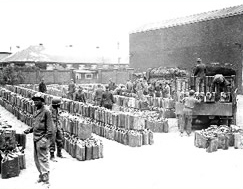9-15 September 1944
Red Ball Express
Following their successful landing on Normandy beachhead in early June 1944, the Allies had to wage a bloody six-week struggle in the infamous French hedgerows just beyond. Not until the end of July did they manage to breakout and begin pursuing German forces across the heart of France. But then another problem emerged: Petroleum. Or rather the lack of it.
 As Patton’s “Thundering Third” Army raced across France, German resistance all but melted. By mid-August Allied lines of communication stretched between three and four hundred miles from the beachhead. And Patton’s tanks were running low on gas. Starting in late August, Quartermaster and Transportation Corps units opened the “Red Ball Express,” and began moving tens of thousands of tons of precious supplies to the fighting front.
As Patton’s “Thundering Third” Army raced across France, German resistance all but melted. By mid-August Allied lines of communication stretched between three and four hundred miles from the beachhead. And Patton’s tanks were running low on gas. Starting in late August, Quartermaster and Transportation Corps units opened the “Red Ball Express,” and began moving tens of thousands of tons of precious supplies to the fighting front.
By 10 September the Red Ball route had reached Versailles and split into two branches — one bypassed Paris to the north and continued to Soissons to serve the First Army, the other moved in a southeasterly direction in support of the Third Army.
Over the next two months QM and TC trucks carried over 8,000 tons of supplies daily on the Red Ball Express. Nearly half a million tons of supplies in all, including enough petroleum to keep the trucks, tanks, jeeps, and other mechanized vehicles speeding toward victory in Europe.
Read this article from the History & Heritage section for more information: POL on the Red Ball Express
Compiled by Dr. Steven Anders, former Quartermaster School historian.
Quote of the Week:
My men can eat their belts, but my tanks gotta have gas.— General George S. Patton, Jr.,
Conversation with General Eisenhower
2 September 1944
